Design and Implementation of Quad-Port MIMO Antenna with Dual-Band Elimination Characteristics for Ultra-Wideband Applications
Abstract
1. Introduction
2. Antenna Design
2.1. UWB Antenna Element
2.2. Quad-Port MIMO Antenna
3. Results
4. Conclusions
Author Contributions
Acknowledgments
Conflicts of Interest
References
- Federal Communications Commission. First Report and Order, Revision of Part 15 of the Commission’s Rules Regarding Ultrawideband Transmission Systems; Federal Communications Commission: Washington, DC, USA, 2002.
- Chen, Z.N.; Ammann, M.J.; Qing, X.M.; Wu, X.H.; See, T.S.P.; Cai, A. Planar antennas. IEEE Microw. Mag. 2006, 7, 63–73. [Google Scholar] [CrossRef]
- Liang, J.X.; Chian, C.C.; Chen, X.D.; Parini, C.G. Study of a printed circular disc monopole antenna for UWB systems. IEEE Trans. Antennas Propag. 2005, 53, 3500–3504. [Google Scholar] [CrossRef]
- Doddipalli, S.; Kothari, A. Compact UWB antenna with integrated triple notch bands for WBAN applications. IEEE Access 2019, 7, 183–190. [Google Scholar] [CrossRef]
- Nekoogar, F. Ultra-Wideband Communications: Fundamentals and Applications; Prentice-Hall: Upper Saddle River, NJ, USA, 2006. [Google Scholar]
- Sarkar, D.; Srivastava, K.V. Compact four-element SRR-loaded dual-band MIMO antenna for WLAN/WiMAX/WiFi/4G-LTE and 5G applications. Electron. Lett. 2017, 53, 1623–1624. [Google Scholar] [CrossRef]
- Ramachandran, A.; Pushpakaran, S.V.; Pezholil, M.; Kesavath, V. A four-port MIMO antenna using concentric square-ring patches loaded with CSRR for high isolation. IEEE Antennas Wirel. Propag. Lett. 2016, 15, 1196–1199. [Google Scholar] [CrossRef]
- Abbas, A.; Hussain, N.; Jeong, M.-J.; Park, J.; Shin, K.S.; Kim, T.; Kim, N. A rectangular notch-band UWB antenna with controllable notched bandwidth and centre frequency. Sensors 2020, 20, 777. [Google Scholar] [CrossRef] [PubMed]
- Rahman, M.; Ko, D.-S.; Park, J.-D. A compact multiple notched ultra-wide band antenna with an analysis of the CSRR-tO-CSRR coupling for portable UWB applications. Sensors 2017, 17, 2174. [Google Scholar] [CrossRef] [PubMed]
- Toktas, A. G-shaped band-notched ultra-widebandMIMO antenna system for mobile terminals. IET Microw. Antennas Propag. 2017, 11, 718–725. [Google Scholar] [CrossRef]
- Tao, J.; Feng, Q. Compact UWB band-notch MIMO antenna with embedded antenna element for improved band notch filtering. Prog. Electromagn. Res. C 2016, 67, 117–125. [Google Scholar] [CrossRef]
- Liu, L.; Cheung, S.W.; Yuk, T.I. Compact MIMO antenna for portable UWB applications with band-notched characteristic. IEEE Trans. Antennas Propag. 2015, 63, 1917–1924. [Google Scholar] [CrossRef]
- Gao, P.; He, S.; Wei, X.; Xu, Z.; Wang, N.; Zheng, Y. Compact printed UWB diversity slot antenna with 5.5-GHz band-notched characteristics. IEEE Antennas Wirel. Propag. Lett. 2014, 13, 376–379. [Google Scholar] [CrossRef]
- Li, W.T.; Hei, Y.Q.; Subbaraman, H.; Shi, X.W.; Chen, R.T. Novel printed filtenna with dual notches and good out-of-band characteristics for UWB-MIMO applications. IEEE Microw. Wirel. Compon. Lett. 2016, 26, 765–767. [Google Scholar] [CrossRef]
- Liu, Y.Y.; Tu, Z.H. Compact differential band-notched stepped-slot UWB-MIMO antenna with common-mode suppression. IEEE Antennas Wirel. Propag. Lett. 2017, 16, 593–596. [Google Scholar] [CrossRef]
- Wu, W.; Yuan, B.; Wu, A. A quad-element UWB-MIMO antenna with band-notch and reduced mutual coupling based on EBG structures. Int. J. Antennas Propag. 2018, 8490740, 1–10. [Google Scholar] [CrossRef]
- Kiem, N.K.; Phuong, H.N.B.; Chien, D.N. Design of compact 4× 4 UWB-MIMO antenna with WLAN band rejection. Int. J. Antennas Propag. 2014, 2014, 539094. [Google Scholar] [CrossRef]
- Shehata, M.; Said, M.S.; Mostafa, H. Dual notched band quad-element MIMO antenna with multitone interference suppression for IR-UWB wireless applications. IEEE Trans. Antennas Propag. 2018, 66, 5737–5746. [Google Scholar] [CrossRef]
- Patre, S.R.; Singh, S.P. Broadband multiple-input-multiple-output antenna using castor leaf-shaped quasi-self-complementary elements. IET Microw. Antennas Propag. 2016, 10, 1673–1681. [Google Scholar] [CrossRef]
- Sharawi, M.S. Current misuses and future prospects for printed multiple-input, multiple-output antenna systems [Wireless Corner]. IEEE Antennas Propag. Mag. 2017, 59, 162–170. [Google Scholar] [CrossRef]
- Blanch, S.; Romeu, J.; Corbella, I. Exact representation of antenna system diversity performance from input parameter description. Electron. Lett. 2003, 39, 705–707. [Google Scholar] [CrossRef]
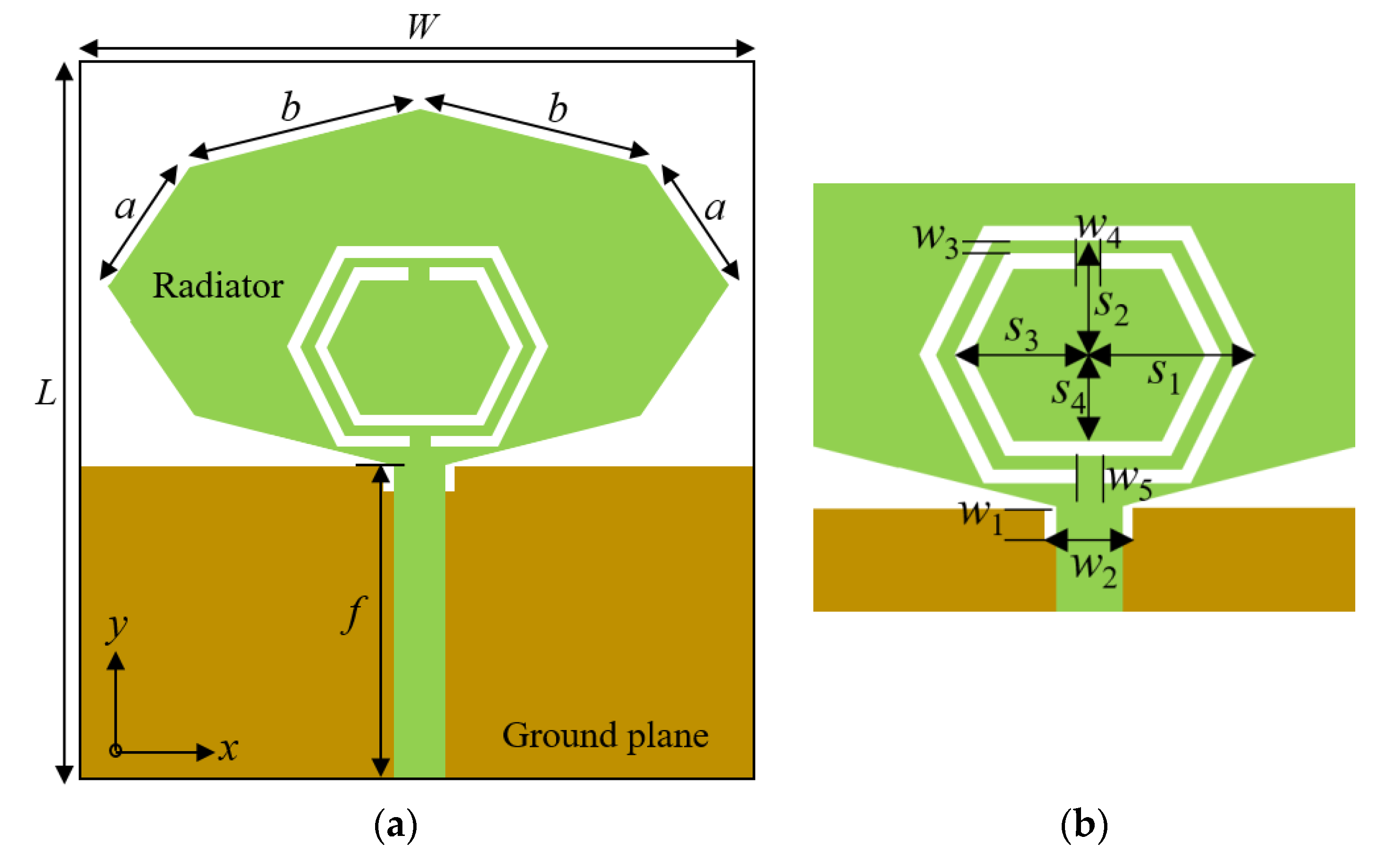
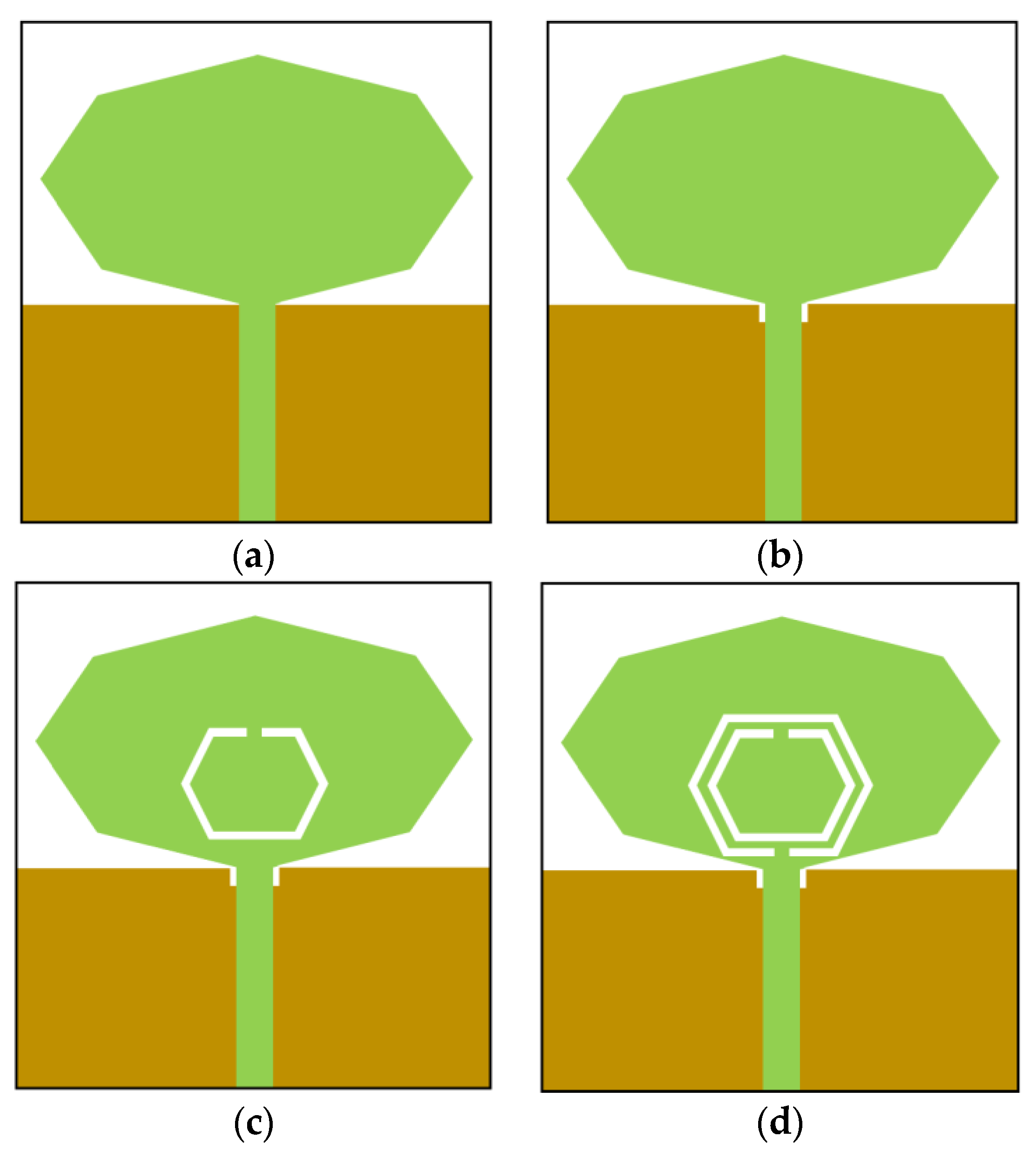
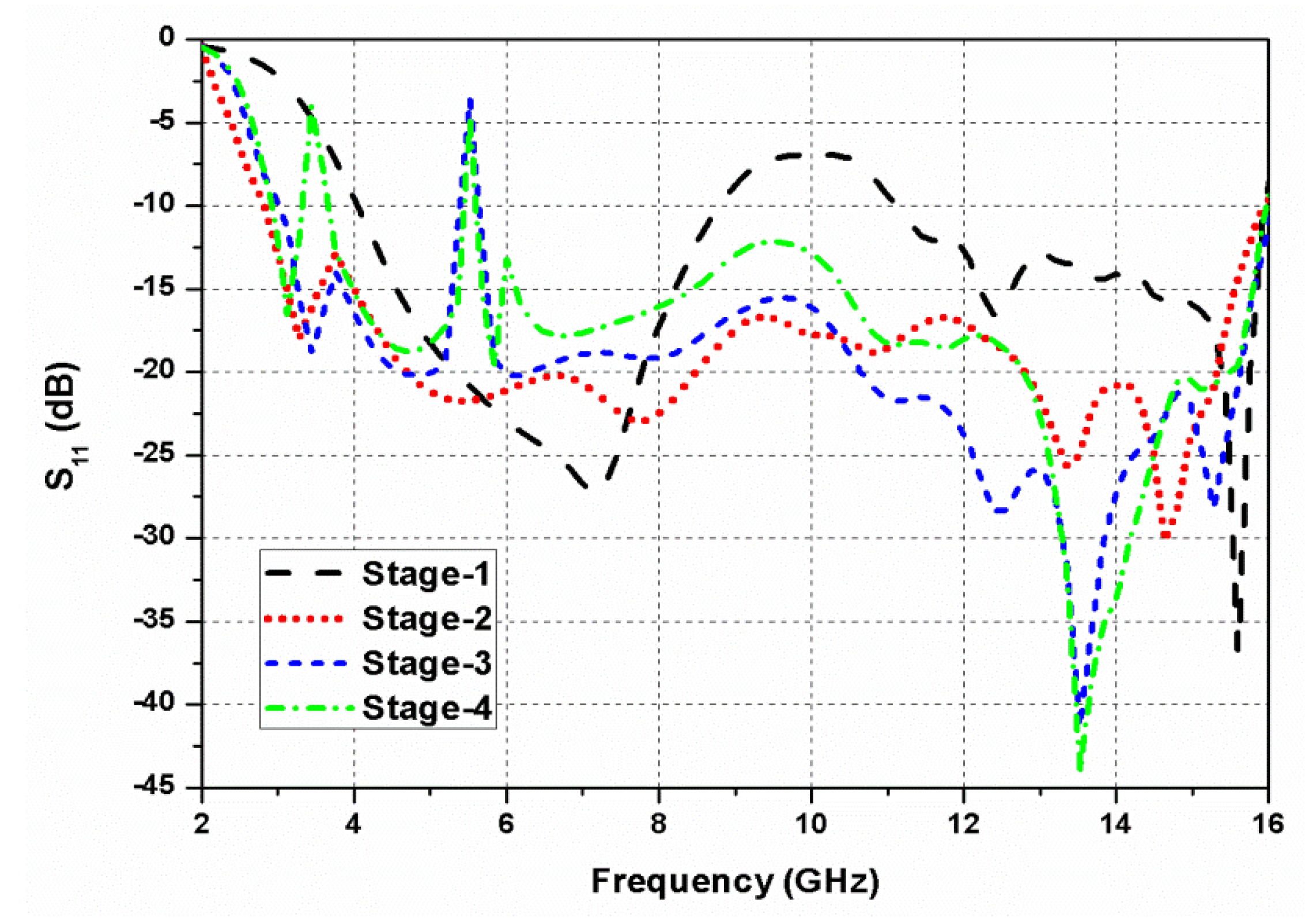

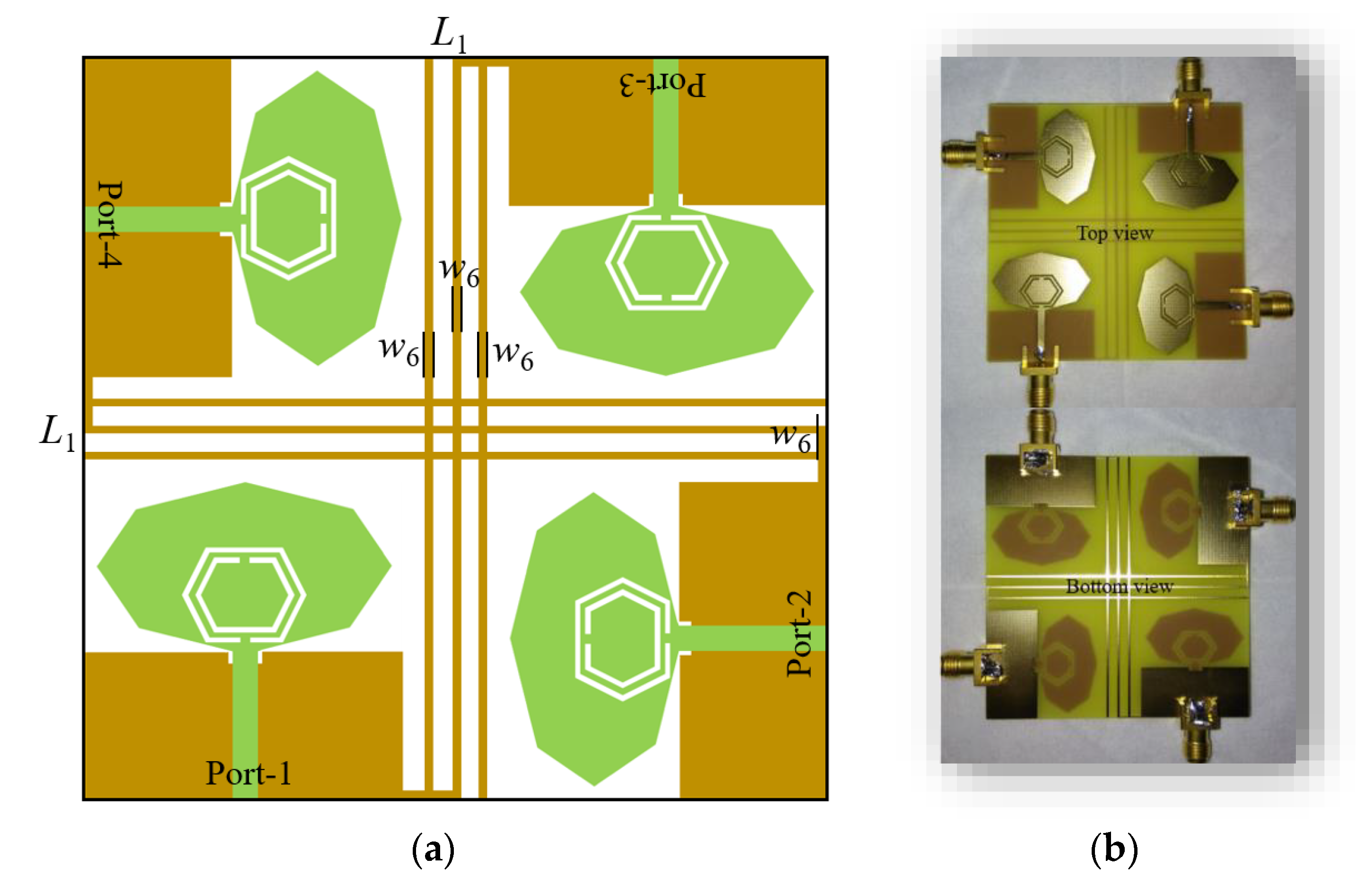
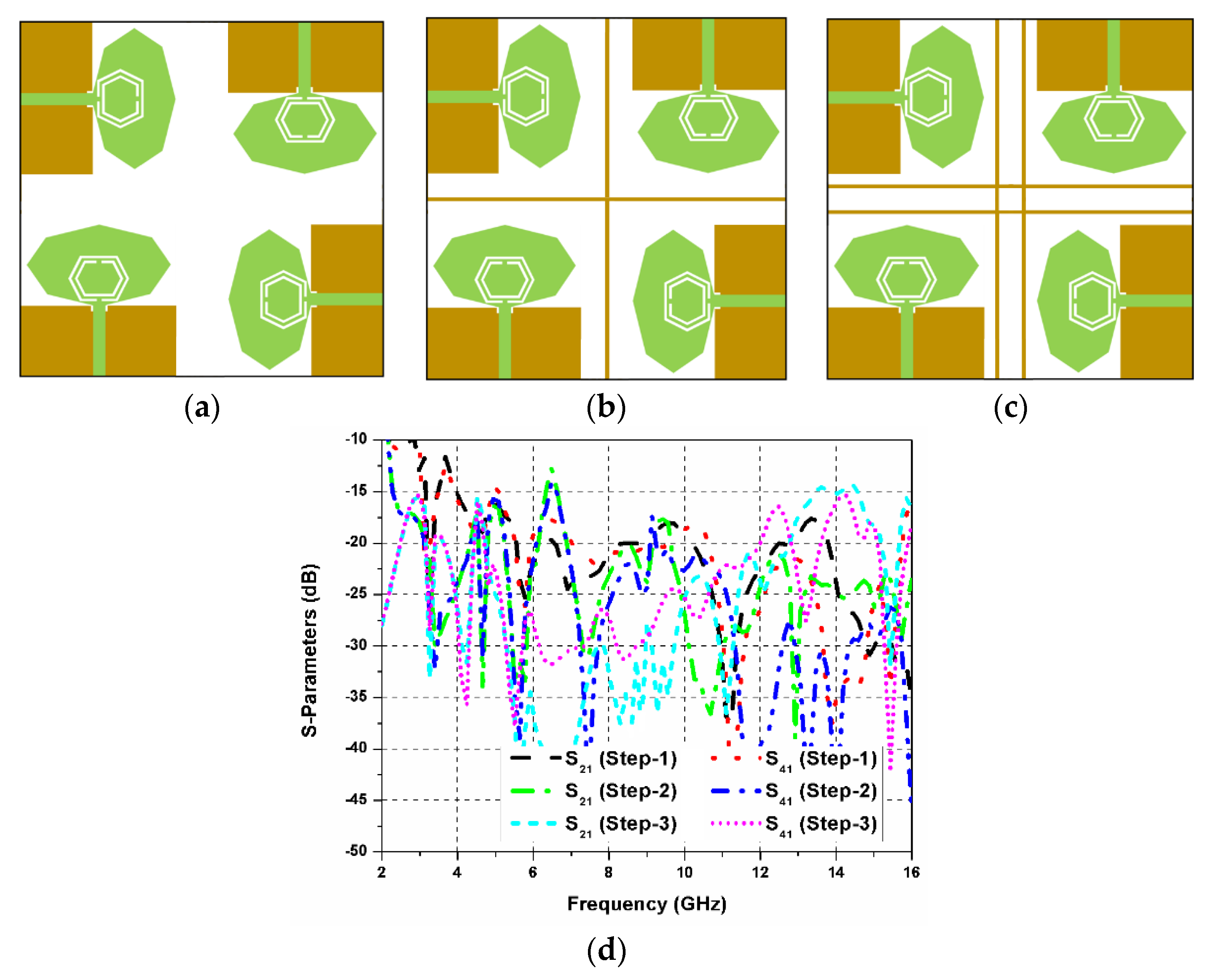

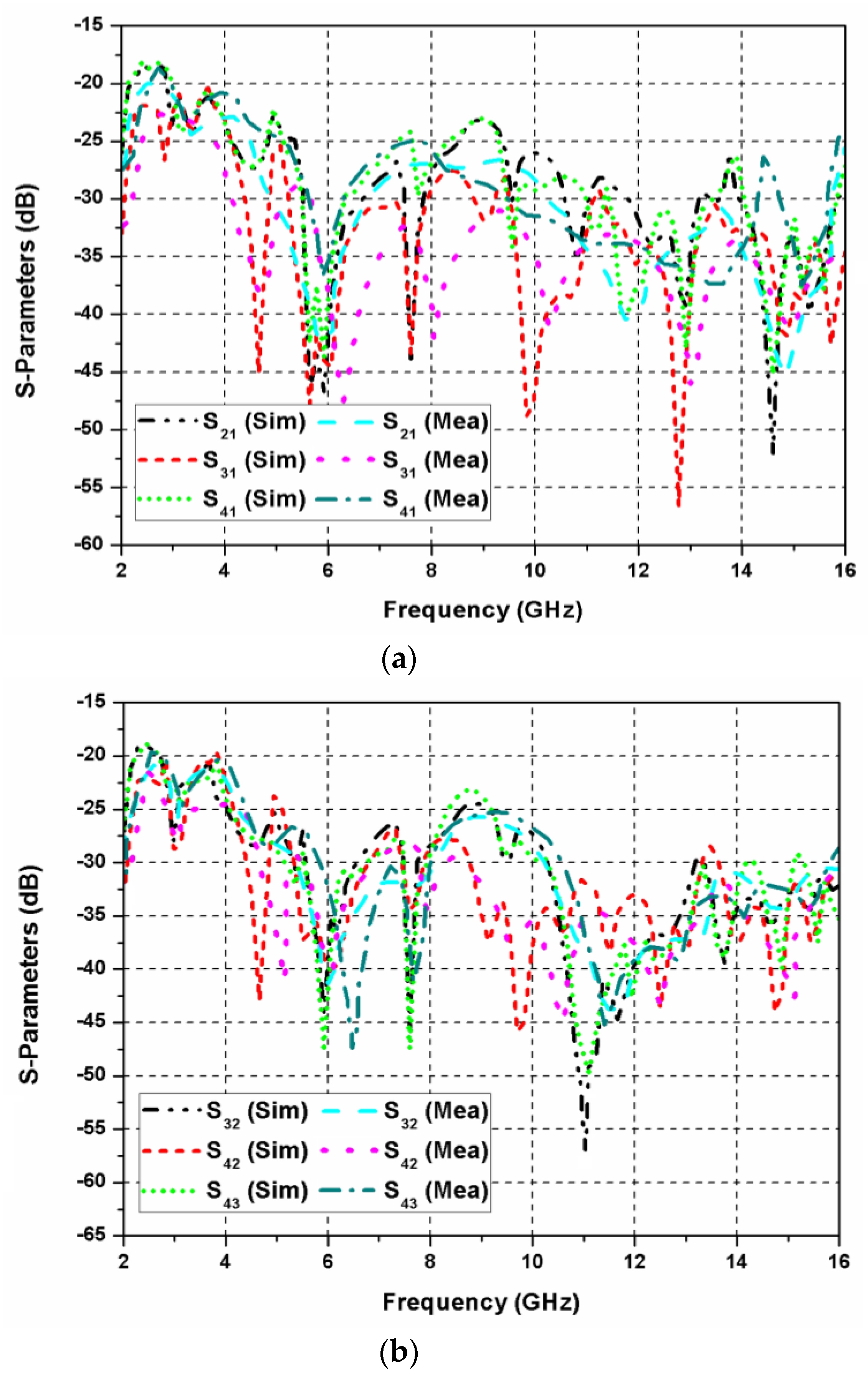
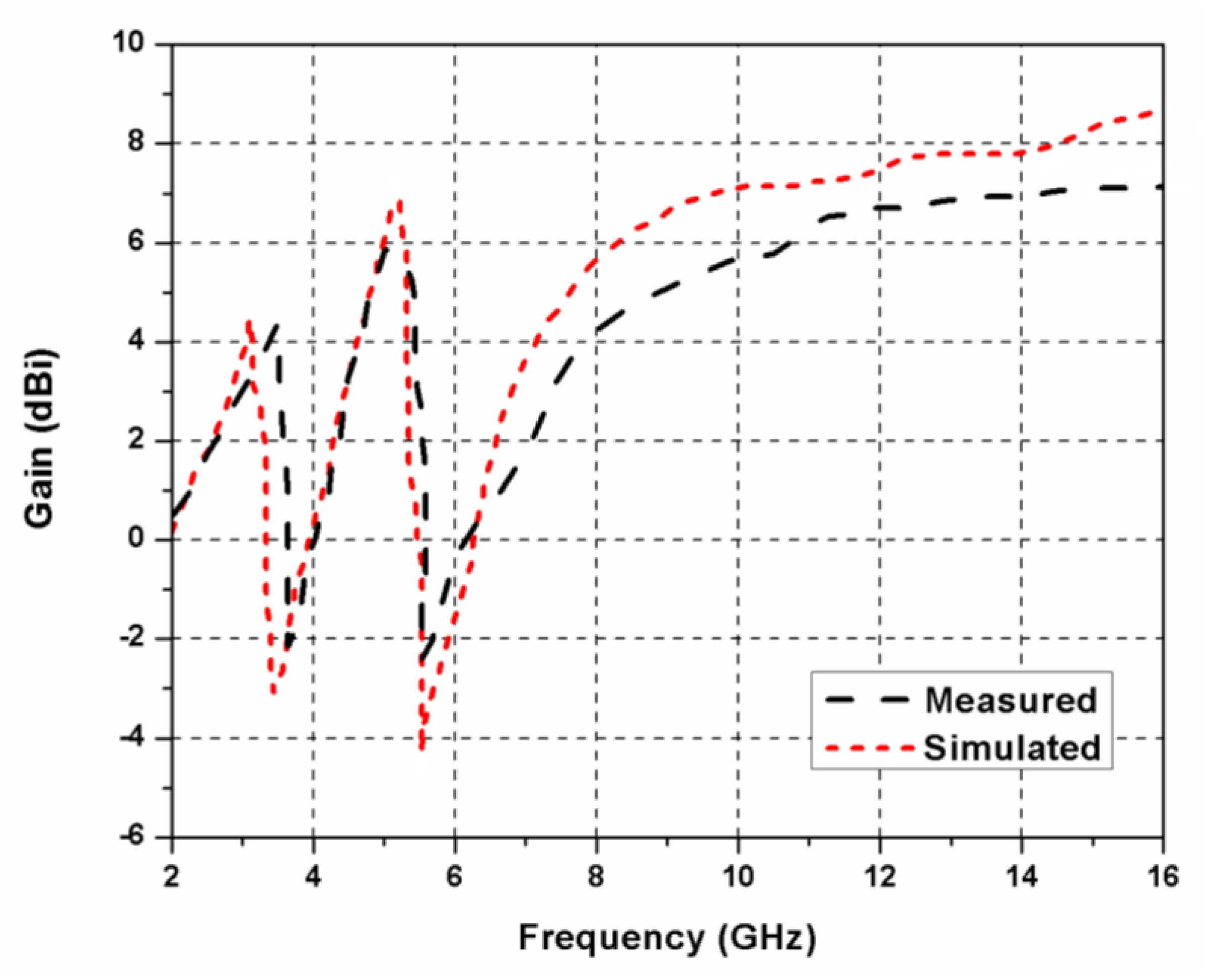
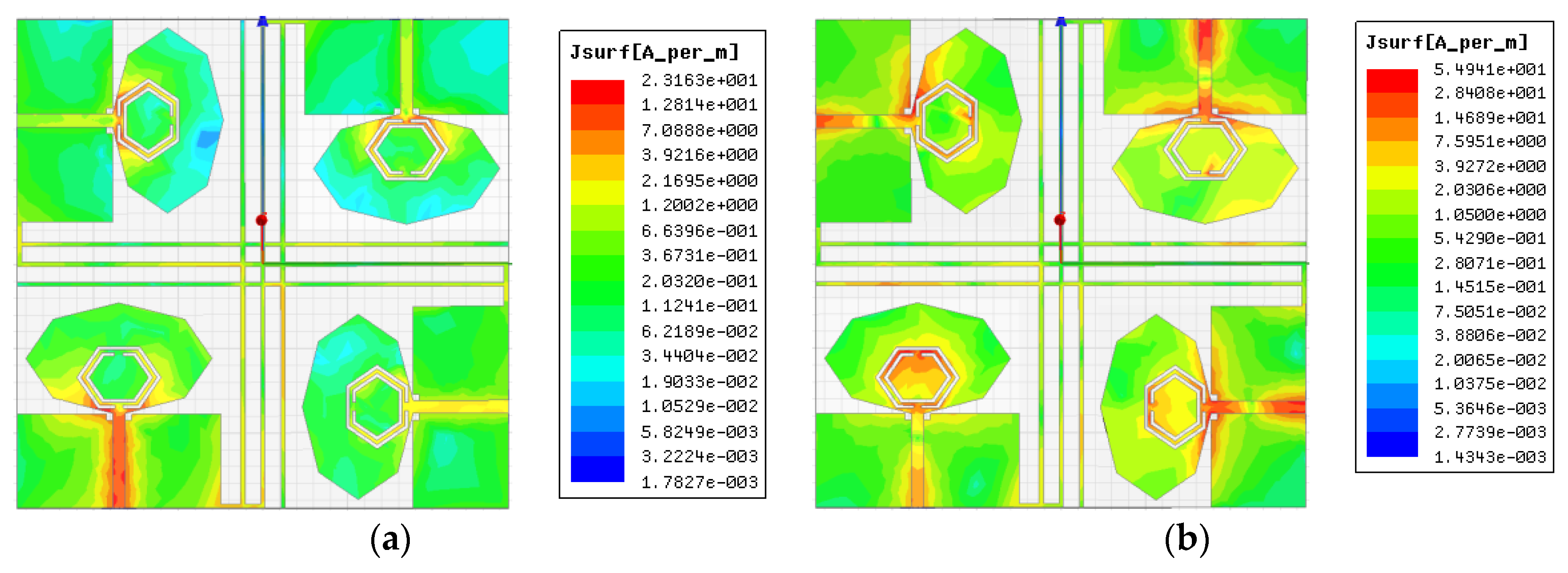
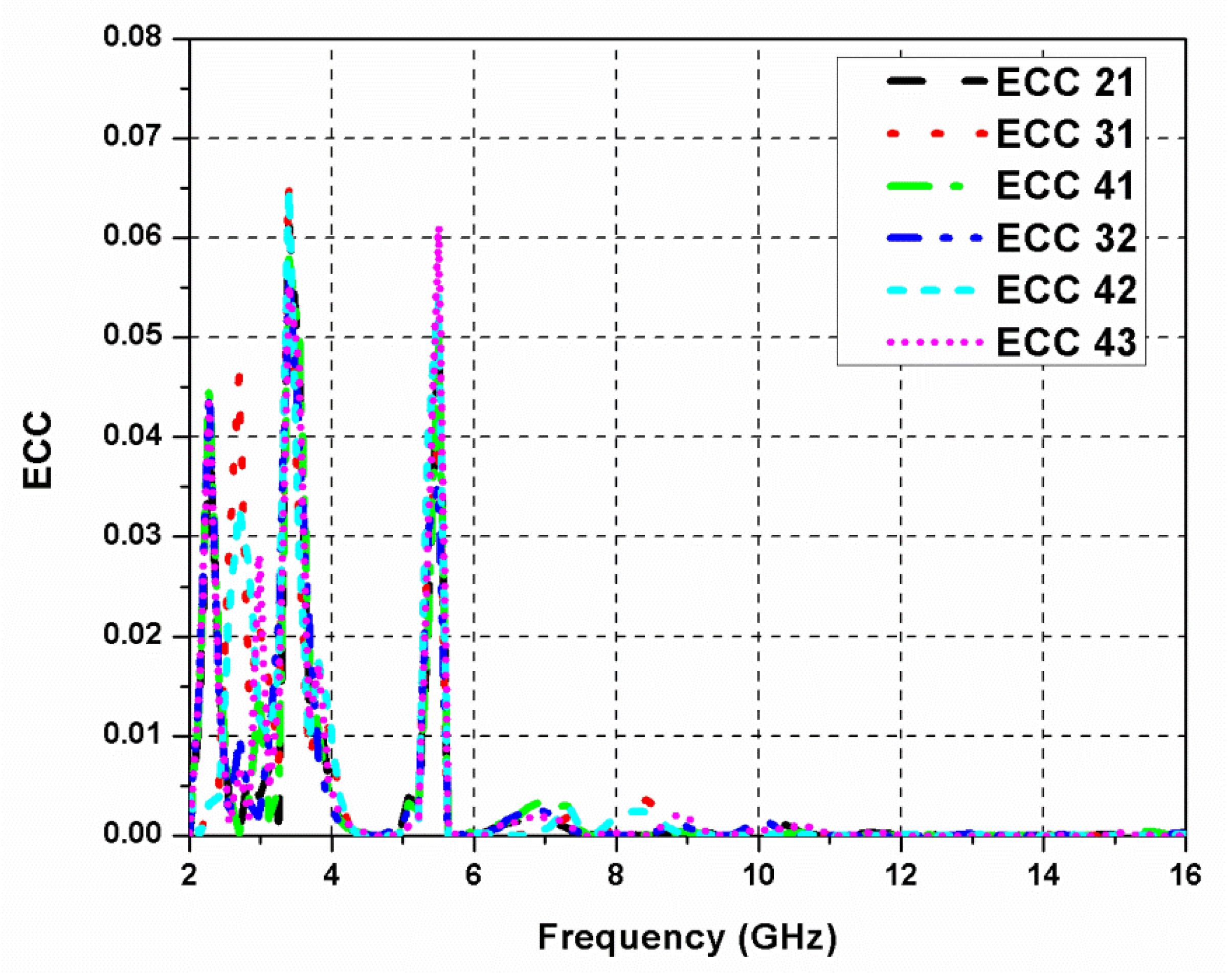
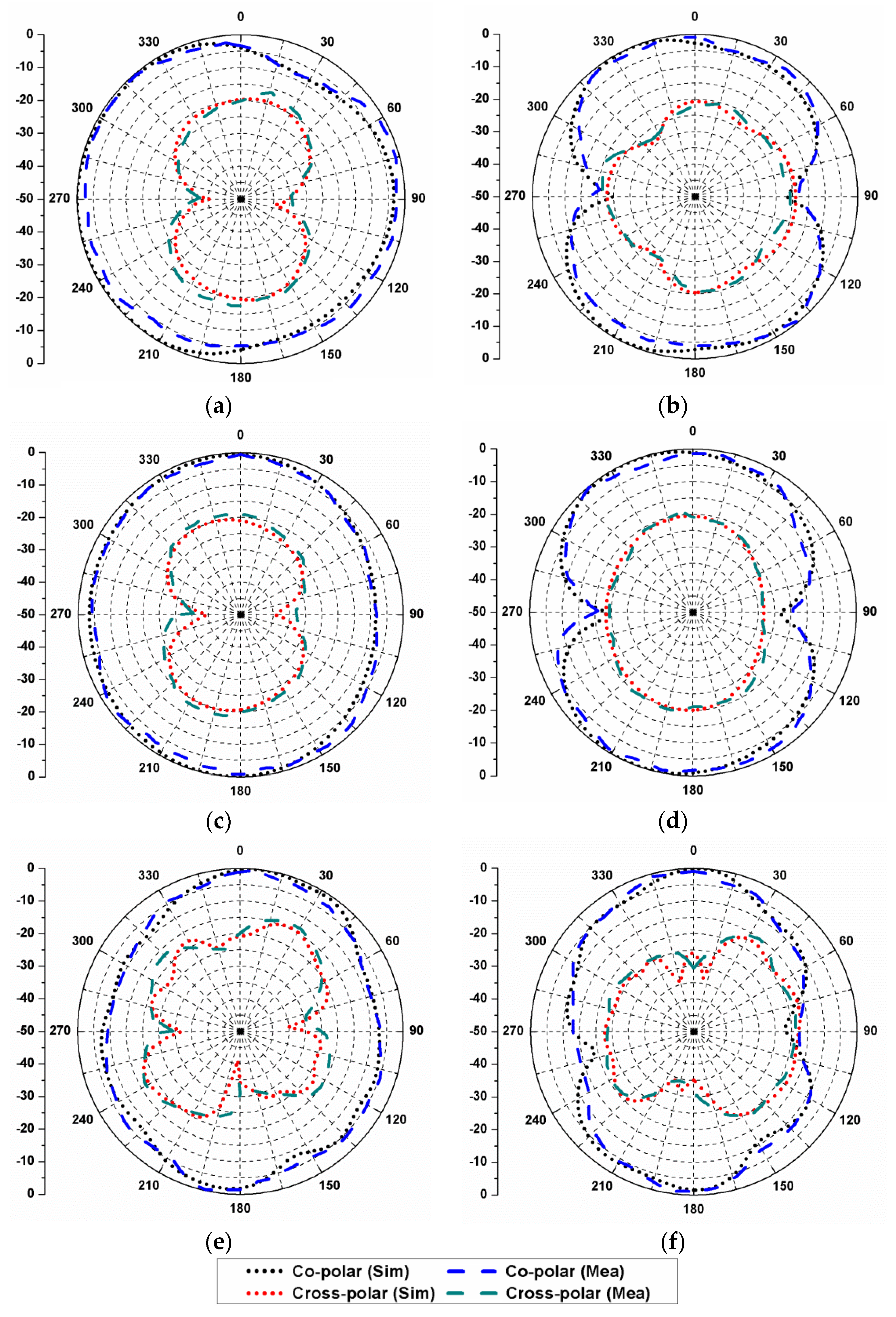
| Parameter | Dimension (mm) | Parameter | Dimension (mm) |
|---|---|---|---|
| L | 26 | w1 | 1 |
| W | 24 | s4 | 3.5 |
| a | 5.7 | w2 | 2.5 |
| b | 8 | w3 | 0.4 |
| f | 11.25 | w4 | 1 |
| s1 | 5 | w5 | 1 |
| s2 | 4.5 | L1 | 58 |
| s3 | 4 | w6 | 0.5 |
| Ref. | Element Number | Bandwidth (GHz) | Size of the Antenna (mm3) | Notch Band Number | Notched Frequency (GHz) | Isolation (dB) | ECC |
|---|---|---|---|---|---|---|---|
| [10] | 2 | 2.2–13.35 | 50 × 82 × 1.6 | 1 | 4.4–6.2 | >15 | <0.04 |
| [11] | 2 | 3.1–10.6 | 30 × 22 × 0.8 | 1 | 5–6 | >15 | <0.05 |
| [12] | 2 | 3.1–11 | 22 × 36 × 1.6 | 1 | 5.15–5.85 | >15 | <0.1 |
| [13] | 2 | 2.5–12 | 48 × 48 × 0.8 | 1 | 5.5 | >15 | <0.005 |
| [14] | 2 | 3.1–10.65 | 35 × 68 × 1 | 2 | 3.35–3.55, 5.65–5.95 | >20 | <0.002 |
| [15] | 4 | 2.95–10.8 | 44 × 44 × 1.6 | 1 | 5.10–5.95 | >15.5 | <0.1 |
| [16] | 4 | 3–16.2 | 60 × 60 × 1.6 | 1 | 4.6 | >17.5 | <0.4 |
| [17] | 4 | 2.73–10.68 | 60 × 60 × 1.6 | 1 | 5.36–6.34 | >15 | <0.5 |
| [18] | 4 | 2–15 | 100 × 100 × 1.6 | 2 | 3.5, 5.5 | >20 | <0.1 |
| Prop. | 2 | 3–16 | 58 × 58 × 0.8 | 2 | 3.5, 5.5 | >18 | <0.07 |
© 2020 by the authors. Licensee MDPI, Basel, Switzerland. This article is an open access article distributed under the terms and conditions of the Creative Commons Attribution (CC BY) license (http://creativecommons.org/licenses/by/4.0/).
Share and Cite
Kumar, P.; Urooj, S.; Alrowais, F. Design and Implementation of Quad-Port MIMO Antenna with Dual-Band Elimination Characteristics for Ultra-Wideband Applications. Appl. Sci. 2020, 10, 1715. https://doi.org/10.3390/app10051715
Kumar P, Urooj S, Alrowais F. Design and Implementation of Quad-Port MIMO Antenna with Dual-Band Elimination Characteristics for Ultra-Wideband Applications. Applied Sciences. 2020; 10(5):1715. https://doi.org/10.3390/app10051715
Chicago/Turabian StyleKumar, Pawan, Shabana Urooj, and Fadwa Alrowais. 2020. "Design and Implementation of Quad-Port MIMO Antenna with Dual-Band Elimination Characteristics for Ultra-Wideband Applications" Applied Sciences 10, no. 5: 1715. https://doi.org/10.3390/app10051715
APA StyleKumar, P., Urooj, S., & Alrowais, F. (2020). Design and Implementation of Quad-Port MIMO Antenna with Dual-Band Elimination Characteristics for Ultra-Wideband Applications. Applied Sciences, 10(5), 1715. https://doi.org/10.3390/app10051715






